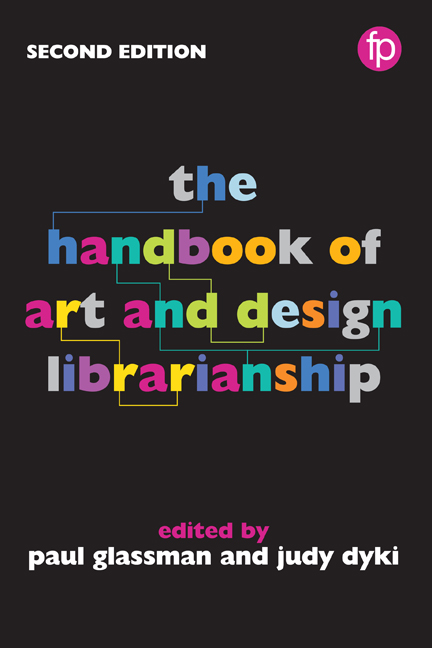Book contents
- Frontmatter
- Contents
- List of figures and tables
- Notes on contributors
- Foreword
- Preface
- Part I Roles and responsibilities
- Part II Materials and collection management
- Part III Teaching and learning
- 14 Embedded in their world: moving mentally into the studio environment
- 15 Teaching with threshold concepts and the ACRL Framework in the art and design context
- 16 Teaching by the book: art history pedagogy and special collections
- 17 Metaliteracy in art and design education: implications for library instruction
- 18 The art of evidence: a method for instructing students in art history research
- 19 ‘I want students to research the idea of red’: using instructional design for teaching information literacy in the fine arts
- 20 Cultural differences and information literacy competencies
- Part IV Knowledge creation
- Part V The physical environment
- Part VI Promotion and sustainability
- Appendix Library profiles
- Index
19 - ‘I want students to research the idea of red’: using instructional design for teaching information literacy in the fine arts
from Part III - Teaching and learning
Published online by Cambridge University Press: 08 June 2018
- Frontmatter
- Contents
- List of figures and tables
- Notes on contributors
- Foreword
- Preface
- Part I Roles and responsibilities
- Part II Materials and collection management
- Part III Teaching and learning
- 14 Embedded in their world: moving mentally into the studio environment
- 15 Teaching with threshold concepts and the ACRL Framework in the art and design context
- 16 Teaching by the book: art history pedagogy and special collections
- 17 Metaliteracy in art and design education: implications for library instruction
- 18 The art of evidence: a method for instructing students in art history research
- 19 ‘I want students to research the idea of red’: using instructional design for teaching information literacy in the fine arts
- 20 Cultural differences and information literacy competencies
- Part IV Knowledge creation
- Part V The physical environment
- Part VI Promotion and sustainability
- Appendix Library profiles
- Index
Summary
Despite the different contexts in which art librarians serve – in universities, museums, special collections, auction houses – information literacy instruction occurs in all of them. The librarian as educator is a common enough paradigm in the 21st century, although that role often brings discomfort to practitioners with no formal training in teaching. Instructional design models provide structure and support to the librarian while creating and implementing lessons. These models engage the librarian in a systematic process, scaffolding the steps needed to create user-centred, effective instruction, whether the target audience is museum docent volunteers or graduate students. This chapter provides a brief introduction to the discipline of instructional design and some of its resources and then explores the use of a library-centred instructional design model in an undergraduate studio art classroom.
What is instructional design?
Instructional design represents both a unique discipline and an approach that all librarians designing learning experiences can integrate into their practices. Instructional design as a field grew out of the programmed instruction movement of the mid-20th century (Skinner, 1954), and the need to use new media (e.g. slides, images, film) in training settings (AECT, 2001). As technology and media have developed, instructional design as a field has similarly progressed. Today, scholars refer to the discipline as ‘the principles and procedures by which instructional materials, lessons, and whole systems can be developed in a consistent and reliable fashion’ (Molenda, Reigeluth and Nelson, 2003, 574). The idea of a systematic approach is key to instructional design because it reflects the intentional, reflective process that individuals should adopt in creating meaningful learning environments (Smith and Ragan, 2005).
Importantly, though, instructional design also represents a way of thinking about teaching and learning that individuals creating diverse educational interactions can adopt to inform their practices. Ritchey, Klein, and Tracey (2011, 3) call instructional design ‘the science and art of creating detailed specifications for the development, evaluation, and maintenance of situations which facilitate learning and performance’, and this definition of the field addresses how it can be integrated into other disciplines. Importantly, this integration needs to follow a series of steps or guidelines (take a systematic focus) so that the resulting instruction's effectiveness is consistent for all learners and measurable through assessment or evaluation.
- Type
- Chapter
- Information
- The Handbook of Art and Design Librarianship , pp. 193 - 202Publisher: FacetPrint publication year: 2017



